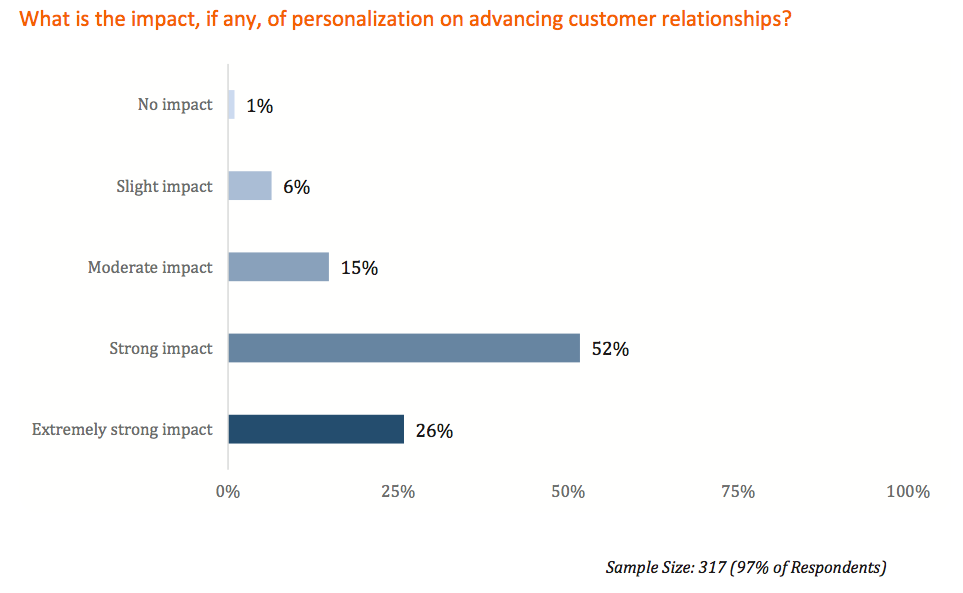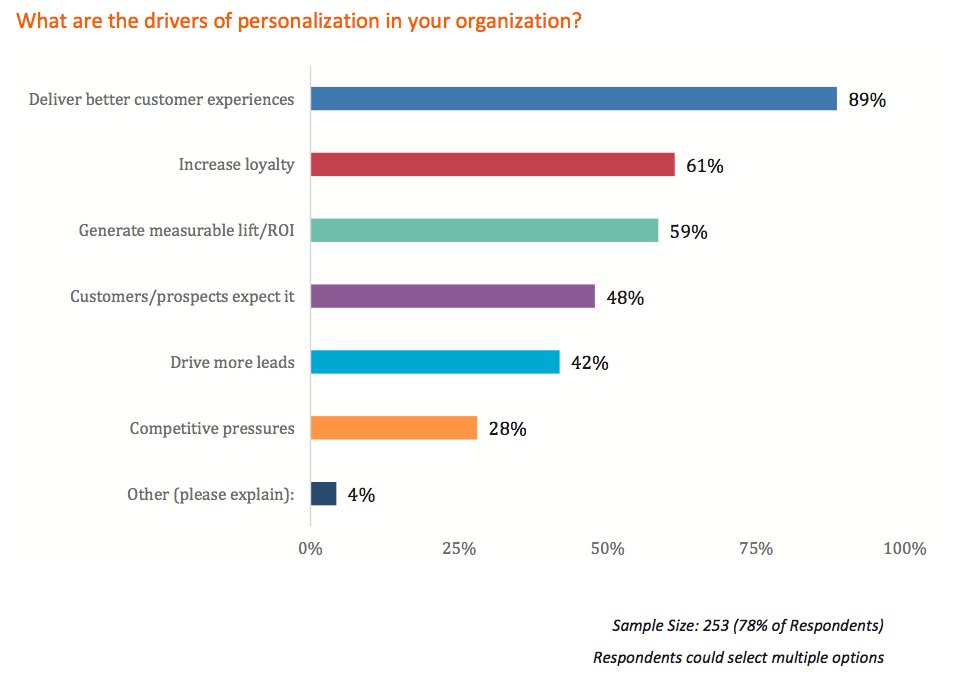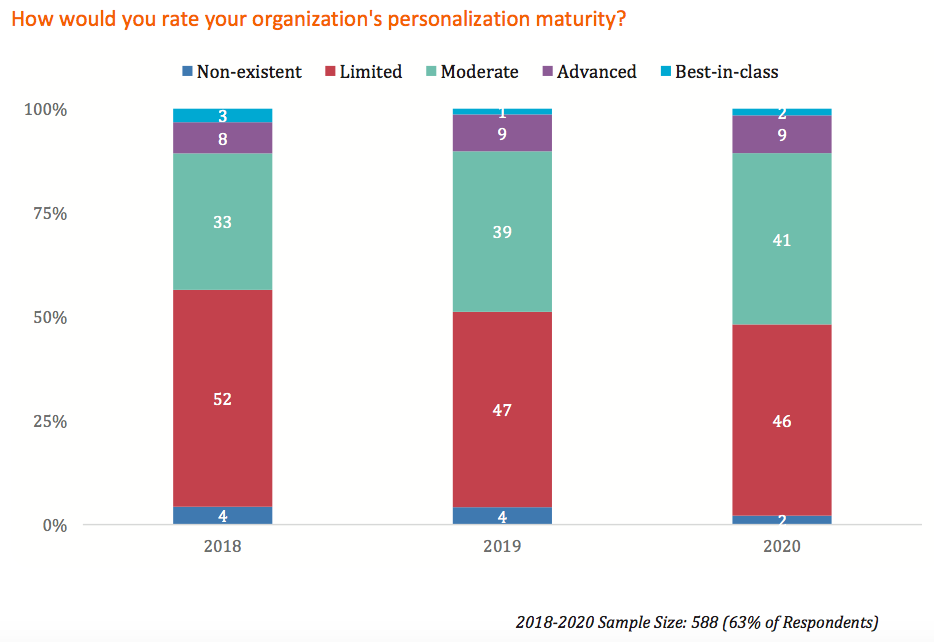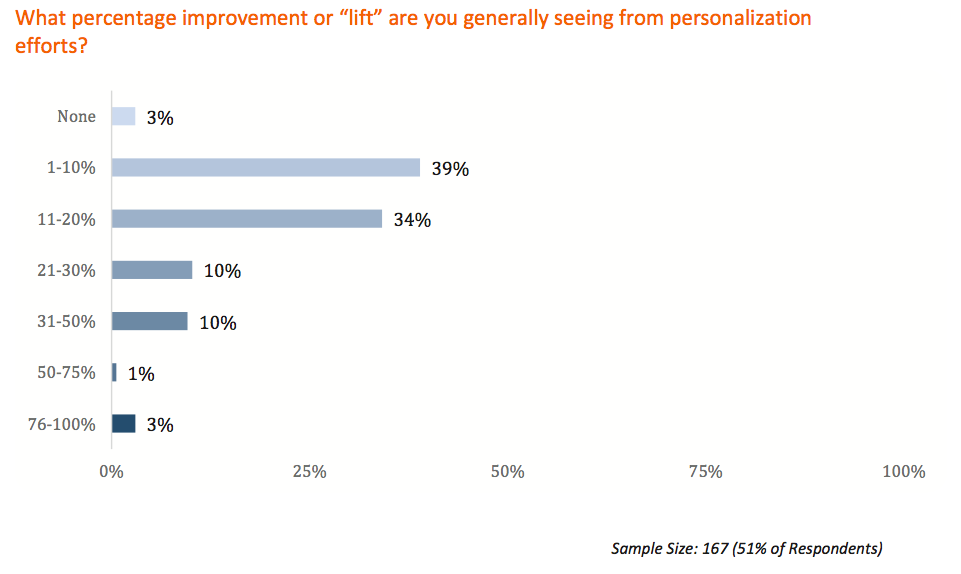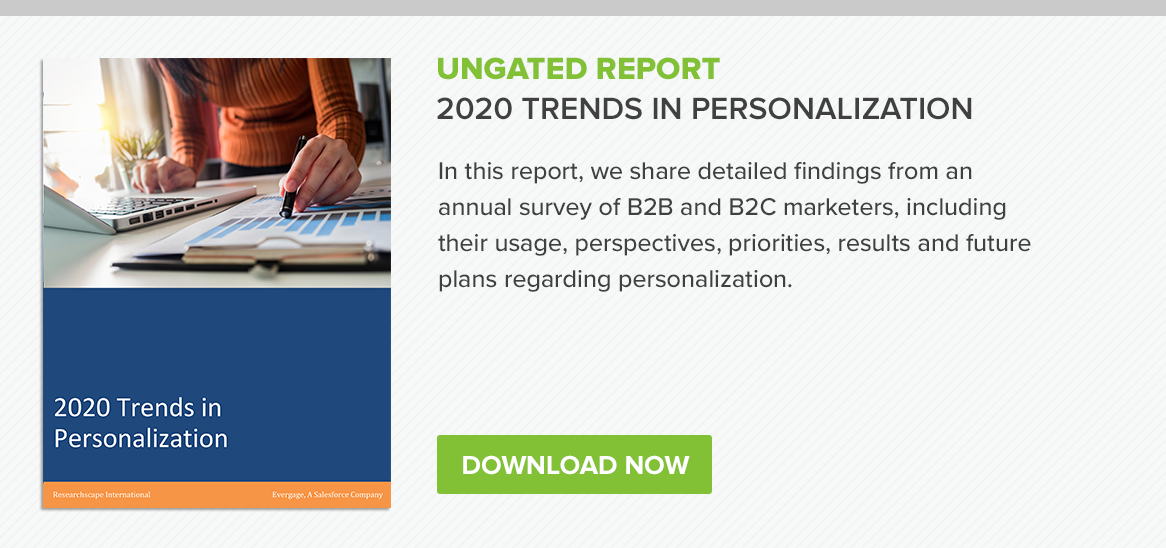
Providing great customer experiences – that are helpful, relevant and engaging – is a priority for companies and marketers across industries. Personalization is key to executing on that and regarded as a necessary component of any successful marketing strategy. Each year, as both customer expectations and technology capabilities mature, it becomes increasingly clear that personalization has a profound impact on customer experience (CX) and plays a critical role in advancing customer relationships.
In our 7th annual Trends in Personalization survey, conducted with Researchscape International, we explored marketers’ perspectives on – and approaches to – personalization, along with the results they’ve seen and how they’re thinking about their programs moving forward. We also hosted a webinar last week, in which Andy Zimmerman, Evergage’s CMO, and Paula Crerar, customer marketing consultant, discussed and analyzed many of the key survey findings.
This blog article highlights several important takeaways from the webinar, but for more in-depth analysis, be sure to check out the full webinar replay.
Personalization is Key to Improving CX
More than ever, marketers believe that personalization is a business requirement and a necessity for fostering lasting relationships with customers and prospects. This year, we found that 99% of marketers say that personalization positively impacts customer relationships – and 78% (up from 70% last year) say that impact is “strong” or “extremely strong.” In addition, 92% of marketers also believe that their prospects and customers expect a personalized experience (up from 85% last year).
With this focus on advancing relationships and delivering what customers want, it naturally follows that marketers’ primary motivation for deploying personalization is to deliver better customer experiences (89%) – even more than increasing loyalty (61%) and generating ROI (59%), the next 2 most popular drivers. And while measurable ROI is still very important, we’ve seen over the years that it’s just not quite as important as it used to be, compared to simply treating your customers and prospects well. Marketers are taking a longer-term view of the value of personalization – and of course, by delivering a better CX, increased loyalty and ROI also typically follow.
Marketers are Taking Steps Toward Improving Personalization Maturity
With greater knowledge of what’s possible when it comes to personalization, customers and marketers both often have high standards for experience delivery. And marketers acknowledge there’s more work to be done. 46% of marketers rate their organization’s personalization maturity as “limited,” and 41% call it “moderate,” while just over 1 in 10 (11%) say their programs are “advanced” or “best in class.”
There are bright spots, though, as maturity has been trending upward over the last 3 years – with an increase in “moderate” ratings from 33% in 2018 to 41% now, as well as a decrease in marketers who rate their company’s personalization maturity as “non-existent” or “limited” (56% in 2018, compared to 48% now). This is an indication that marketers are advancing their skills and sophistication with personalization.
Marketers Are Employing More Sophisticated Tactics
Email (78%) and websites (56%) are the two most personalized channels, and the programs deployed through each are becoming increasingly advanced. For example:
- Inline content (which allows marketers to dynamically add or insert sections of content to a page, screen or email) is the most popular personalization format – with 62% of marketers using this method, up 12 percentage points from last year. Inline content provides a more natural personalization experience and doesn’t disrupt customers on their journeys.
- Nearly half of marketers (48%) using email personalization are triggering emails based on visitor behaviors, up 3 points from last year. Triggered emails map to customers’ interests and actions, and can remind them to complete a purchase or take the desired next step.
- And usage of machine learning for personalization is on the rise, up from 26% in 2018 to 46% in 2020. Machine learning, a form of artificial intelligence, is key to delivering personalization at scale, especially at the 1-to-1 level.
These personalization methods are more advanced, and the experiences that result are also often preferred by customers. For example, inline content creates a more seamless experience, triggered emails are timely and tailored to a person’s needs and interests in the moment, and machine-learning personalization factors all available data, across channels, for more spot-on recommendations. All of this suggests that marketers are dedicating time and resources to advancing their personalization skills.
Despite Challenges, Strong Results Prompt Greater Prioritization of Personalization Programs
Even though marketers have made strides in personalizing experiences, most still see room for improvement. For example, 52% of marketers are “not satisfied” or only “slightly satisfied” with the level of personalization used in their marketing efforts, while 35% are “moderately satisfied.” What’s holding them back? More than half (56%) cite a lack of sufficient data and insights. In addition, 54% say lack of personnel is an obstacle in making personalization a bigger priority in their organization, followed by a lack of budget (44%).
However, these barriers continue to diminish. And with increasingly impressive results and proven ROI from personalization, marketers are overcoming some of these challenges and improving the experiences they deliver. As a result, they’re seeing impressive benefits:
- 97% of marketers see measurable lift in business results with personalization.
- 58% see lift higher than 10%.
- Lift has also been trending up over the past 3 years. For example, 87% of marketers reported lift with personalization in 2018, compared to 90% in 2019, and 97% in this year’s report.
Considering these results, along with personalization’s meaningful impact on CX, it’s no surprise that 85% of marketers believe personalization should be a bigger priority in their organization. What’s more, 97% of businesses are planning to increase or maintain their personalization budget this year – underscoring the critical business impact of personalization and that personalization programs are here to stay.
Wrap-Up
In today’s climate, businesses are strengthening their digital postures. For many companies, online channels are now the only way to reach customers – so delivering well-executed, streamlined, personalized experiences that help customers get what they want and need is more important than ever.
This year’s survey results, largely collected at the beginning of the pandemic (data collected Feb. 20-March 27), still reflect the upward trends in growth, maturity and benefits we’ve seen throughout the years, and show that personalization remains at the forefront of marketers’ minds. Customers expect personalized experiences, and marketers have taken action accordingly. Sophistication is on the rise, and the results are impressive – which has led marketers from all industries to recognize the importance not just of personalizing, but of personalizing well. This emphasis on expanding and improving personalization strategies is a trend that is likely to continue in the years to come.
